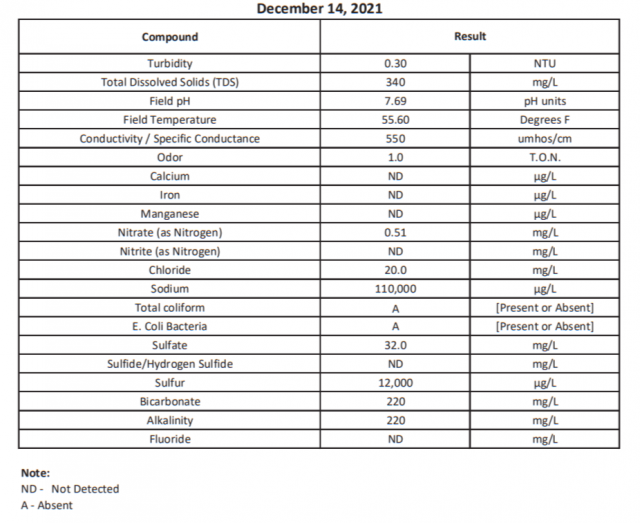I think you need to get another test. The one you posted is about 8 years old. I have well water which is ideal for your fish. When I set up my first tank the pH was 7.3 and my GH was 6 dh and KH was 3-4 dh. About 8 years later a fish keeping friend came by and she had a TDS meter. She tested my water at 83 ppm. After she left I ordered my first TDS meter and checked my KH and GH, Both were down a couple of dh.
I am lazy. It isn't that I don't want to do any thing, rather I always want to find the best solution that also takes the least time and effort to use. After that, cost is the next important factor. So in your situation i would hate to have to go with 100% RO/DI and remineralize. You have to make the most water, you have to spend to remineralize and you spend the most time keeping it all working properly.
So, I would suggest you might try some experiments. You will need to buy a gallon or two of distilled water to substitute for RO/DI. You can try a few mix ratios for one and you can also run both pre and post softened water. You can actually do a decent amount of testing yourself for a lot less than paying to have it done.
We all know we can test for TDS, KH, GH, pH already. Here is what you can get easily and for not a fortune as well:
Iron
Calcium
Magnesium
A decent home softening system will add some sodium to the output water. But this should be pretty low. Here is what might be a worry and I am not sure of this but somebody else here might be. Salt as sodium chloride does not evaporate with water. What this means it there is the potential for it to accumulate in a tank is one is not careful. If one is regular in their water changes and insures there is not often a need to top off a tank, this should prevent the build up of sodium. The softener removes chloride as well the sodium and the chloride is a problem when it is discharged from the system into the environment,.
Finally, if one wishes to keep live plants and/or inverts in a tank, they need the things the softener is removing- iron, calcium and magnesium. In fact, I add all of these to my heavily planted tanks with shrimp and snails in them. I use SeaChem Equilibrium for this. I use way less than is suggested for true remineralization of RO/DI water. I am not defiicent in general obut because of a ton of plants. amano shrimp and assassin snails. There are not enough minerals for them all.
Equilibrium™ is specifically designed to establish the ideal mineral content for the planted aquarium. Equilibrium™ contains no sodium or chloride (which can be detrimental to a planted aquarium at elevated levels). Equilibrium™ is ideally suited for use with RO (reverse osmosis) or DI (deionized) water or any mineral deficient water. Equilibrium™ raises the essential mineral/electrolyte content (General Hardness) of the water to balance with and promote stability of the carbonate hardness.............
......... Equilibrium™ contains NO SODIUM CHLORIDE. Both sodium and chloride are not rapidly depleted elements in a planted aquarium, and, in the case of chloride, can do more harm than good. Competitors’ products generally contain primarily sodium chloride (because it is inexpensive), which will raise the electrolyte levels for fish, but can be detrimental to plant growth. In addition, sodium is not a contributing cation to GH levels. Equilibrium™ contains only calcium, magnesium, and potassium salts, which aid in fish metabolism, but are also highly beneficial to plant growth.
Equilibrium™ guaranteed analysis and symptoms of deficiency
It also contains Iron and manganese. If you look at your well water report shows it has no iron, calcium or manganese. And if it had calcium or iron, the softener would remove these. The water report does not list magnesium at all.
The more complex this stuff is, the more easily one can make a mistake. If one takes their eye of the ball, things can get screwed in up a tank pretty fast. When one is adding things that are either lacking or get used up too quickly, it is even more important to stay on top of them.
One last thought, you kight want to get the output parameters of you softener test so you know exactly what is and isn't in it. This can help you to determine which water source works best- pre or post softener.




